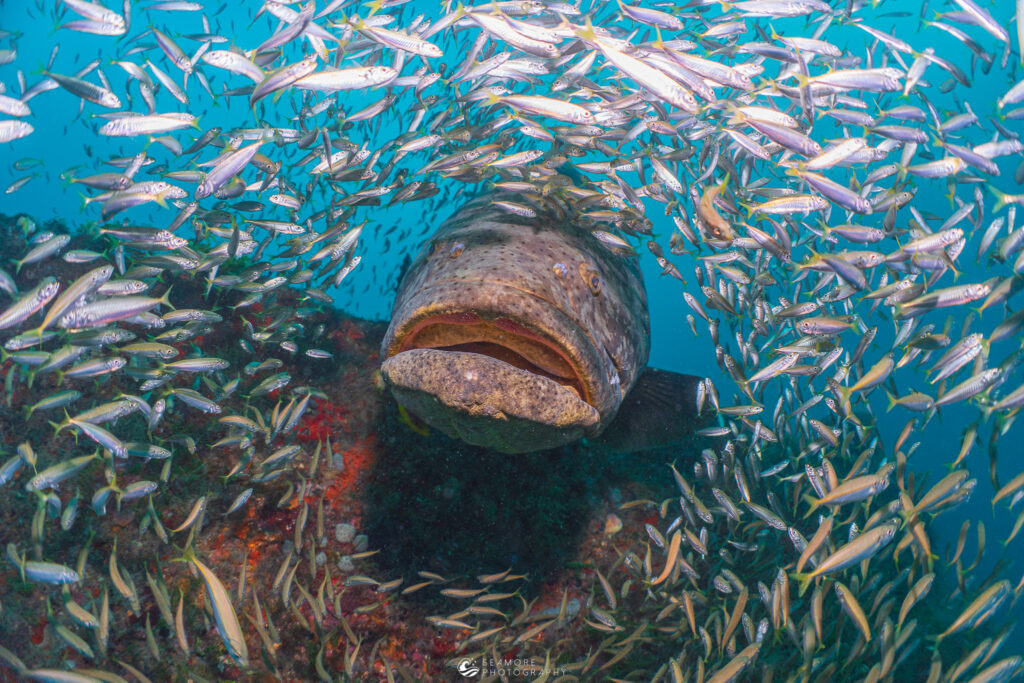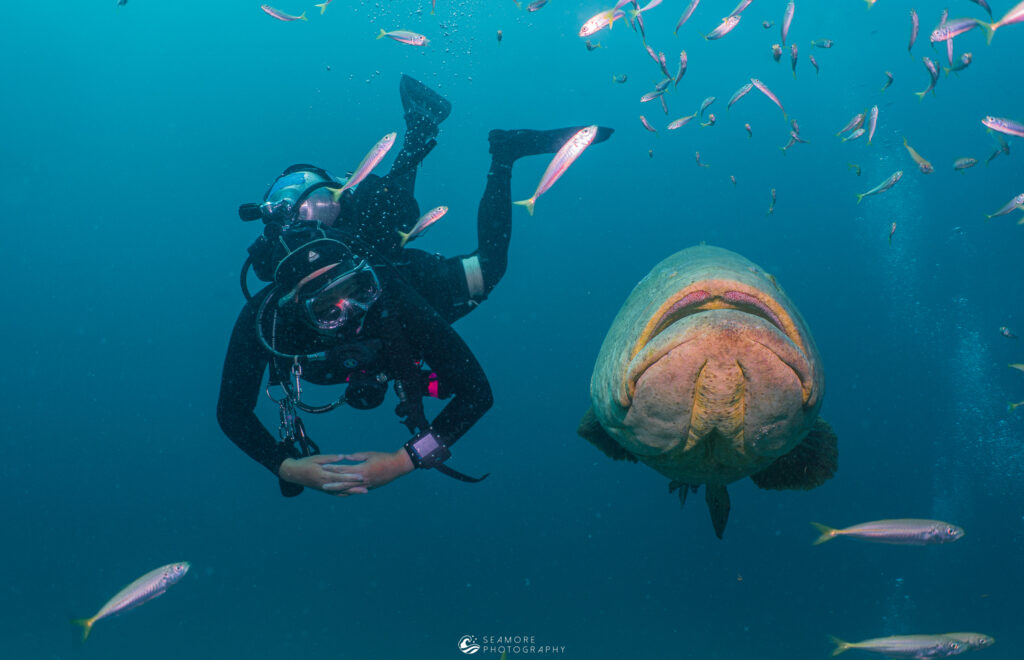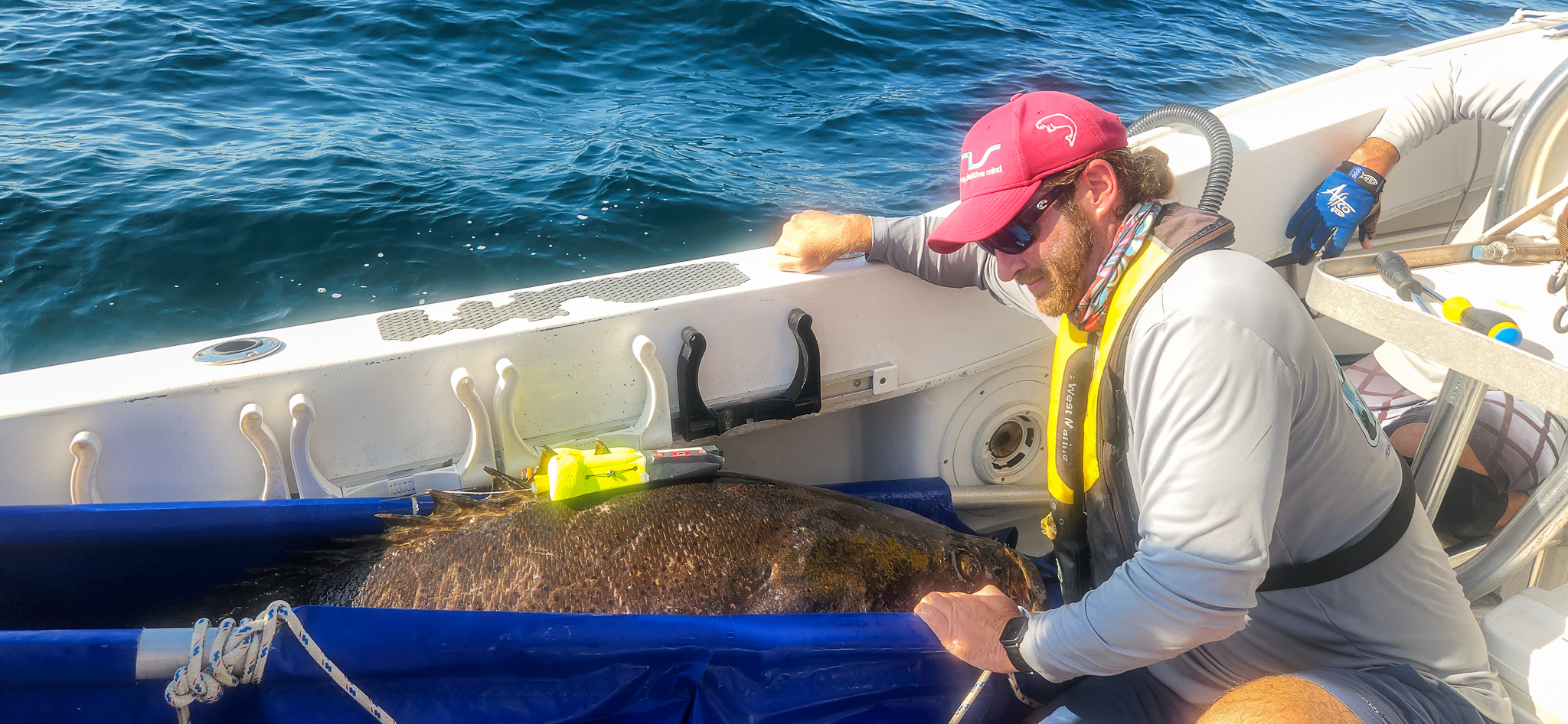Clark Morgan is a Ph.D. Student and photojournalist at Florida Atlantic University, Harbor Branch Oceanographic Institute in Fort. Pierce, Florida. He is a recipient of both a Guy Harvey and a Florida Outdoor Writers Association scholarship.

A goliath grouper surrounded by a school of round scad. Photo by Clark Morgan.
In the age of the Anthropocene, the epoch defined by humans on Earth, a battle for coexistence rages at sea between an iconic, colossal fish and a mercurial opponent dictated by modern society. The Atlantic goliath grouper (Epinephelus itajara, hereafter referred to as “goliath grouper”) is the largest reef dwelling bony fish in the western Atlantic Ocean, with a maximum size up to 2.5 meters in length and 400 kg in weight. This species was once broadly distributed in coastal environments (0-100 m) of the subtropical Americas and Western Africa, including the Gulf of Mexico, with the center of historical abundance located off the southwest coast of Florida. However, excessive overexploitation starting in the 1950s led to a collapse of the population through the 1980s, resulting in a moratorium on harvest in 1990 when federally protected status was implemented. Several factors contributed to this species’ historical demise, such as declining juvenile mangrove habitats due to coastal development, being prized as a popular fishing target, and the innate susceptibility to overfishing because of their natural formations of large aggregations, both as residents and seasonal spawners.
Juvenile goliath grouper settle within inshore estuaries and utilize mangrove ecosystems as nursery habitat before migrating to nearshore and offshore reefs; both juvenile and adults are known to overlap within estuary inlets. This ontogenetic habitat shift normally takes place around one meter of total length, equating to 5-7 years of age. Adults occur on both natural and artificial reefs, with high-relief and high-volume artificial structures like shipwrecks known to support large resident populations. Once established, individual fish may remain resident for many years with evidence of horizontal geographical movement of less than 1 kilometer per year. However, this species is known to make seasonal migrations, sometimes greater than 300 km, to aggerate for mass spawning events.
The federal and state regulations prohibiting goliath grouper harvest have facilitated increasing abundance indicating slow recovery in Florida waters, however there is a lack of evidence indicating that populations have rebounded across their entire historical geographic range. General increased abundance in Florida has created current controversial conversations regarding re-opening the fishery in the state between the Florida Fish and Wildlife Conservation Commission and various stakeholders, most notably anglers and ecotourism-based dive operations. There are increasing “bycatch” or depredation interactions when goliath grouper are incidentally caught when targeting other reef fishes like snapper and smaller grouper, earning them recognition as “nuisance” species in certain areas of Florida. There are also complaints that goliath grouper are invasive and “eat everything else on the reef,” which reflects an example of shifting baseline syndrome such that the human perceptions of “normal” reef ecosystem dynamics have changed with the loss and subsequent recovery of goliath grouper. While goliath grouper depredation is a legitimate concern, studies of their gut contents reveal that typical diets consist of slow-moving benthic organisms, primarily invertebrates and that measures of biodiversity are higher when goliath are present.

A diver swims alongside a goliath grouper. Photo by Clark Morgan.
Conversely, predictable seasonal spawning aggregations of adults (July-October) on nearshore artificial reefs in southeastern Florida support a world class scuba diving industry that provides divers with intimate encounters and unparalleled underwater photography opportunities. Additionally, a targeted catch-and-release recreational fishery is also gaining popularity on both coasts of Florida as some anglers are enthralled by the fight and sight of bringing a fish larger than a fridge to the surface; as large adults cannot be removed the water, people often jump in to get their “trophy” photo with the giant fish.
Recently, FWC approved a limited, highly regulated harvest of 200 juvenile goliath grouper from March 1 to May 31 annually, starting in 2023, with a limited slot (24”-36”) and geographic restrictions intended to limit population impacts. Specifically, juveniles cannot be harvested south of St. Lucie County on the Atlantic coast of Florida, including all the St. Lucie River and its tributaries, and the Atlantic side of the Keys. On the Gulf coast, they cannot be harvested from Dry Tortugas National Park and a maximum of 50 can be harvested from Everglades National Park. Permits will be awarded via a lottery system, require a fee of $150 for residents or $500 for out-of-state non-residents, and participants must submit a fin clip for genetic analysis along with harvest location and fish size. It is worth noting that while collecting fin clips for genetic analysis may be useful for investigating population structure, these samples can be taken non-lethally and are usually more powerful when collected from adults.
While the angler complaints of nuisance interactions are mostly based on large adults on offshore reefs, this slot limit length was selected because the levels of toxic mercury in juvenile muscle tissue are around the EPA’s safe threshold for weekly consumption (~0.46 ppm Muscle Hg); adult goliath grouper tissues contain some of the highest levels of mercury ever recorded in fish (1.0-3.5 ppm Muscle Hg). It is the hope from state regulators that this number of juveniles harvested will provide access to the resource for stakeholders and will not impact the overall population. However, these decisions should not be made on guesses, and it is unorthodox in fisheries management to allow harvest of an individual before it reaches sexual maturity and has a theoretical opportunity to reproduce at least once. Furthermore, pulses of harmful algal blooms, specifically red tide, and extreme cold events continue to hinder population growth of this species and especially juveniles, as they normally inhabit inshore waters that are more susceptible to these acute impacts.
We are familiar with the saying, “There’s plenty of fish in the sea.” While this may be true for some species, we simply don’t know if and how this idea applies to goliath grouper.
Clark Morgan
As a result, this iconic species is once again a hot topic of fisheries management as stakeholders have both vehemently voiced their support and opposition. Although adults remain protected and unviable for consumption because of elevated mercury levels in their tissues, this change in regulation will likely increase the fishing pressure on the adult populations; the same life history characteristics which made them susceptible to overexploitation years ago may haunt the species again. Anecdotal reports of “floating fish” which have not recovered from captured-induced barotrauma/improperly mitigated are rising and are sometimes scavenged on at the surface by large sharks, thus creating unnatural fishing-induced mortality.
Barotrauma is the damage to an animal’s gas-filled organs caused by rapid decreases in pressure and is a common byproduct of rapid ascent to the surface during angler capture. Current sustainable fishing practices in place include recommended weighted descent for reef fishes in the Gulf of Mexico and required weighted descent in federal waters of the South Atlantic.
In February 2023, FWC approved a new regulation requiring barotrauma mitigation devices to be onboard any vessel with anglers targeting reef fish in state waters and further requires the use of the devices when releasing fish. Commercially available pressure-sensitive descending devices (e.g. “SeaQualizer”) are useful for smaller reef-dwelling species like red snapper, and such devices have proven to be effective release methods for deep water groupers. However, the existing descending gear is not adequate for recreational anglers to descend adult goliath grouper due to their large jaws and weight required to submerge the fish, especially when inflated due to barotrauma. An alternative to weighted descent release is venting the swim bladder (e.g. piercing it with a needle to deflate), a method that usually avoids mortality but also damages the organ used to regulate buoyancy in the water column and above the benthos. In goliath grouper, the swim bladder is also used to produce low-frequency, 60 Hz “booming” vocalizations. Considering these vocalizations have illustrated essential roles in communication and courtship in spawning aggregations, venting may not align with the best release practices for this species. However, given the massive size of even small adults, descending devices still need to be researched and developed to better understand the best release practices to avoid unnecessary damage and potential mortality.
Furthermore, there is a paucity of information relating to goliath grouper stock structure because they are not suited to traditional stock assessments as their protected status prohibits the production of historic landings data. Telemetry data have been used to detect goliath grouper spawning activity from ascents within depth profiles and are especially useful when combined with passive acoustic monitoring of “booming” vocalizations. This provides the framework to describe previously undocumented spawning aggregations, which has immediate use as one of FWC’s goals for the upcoming harvest is to reduce the potential impacts of targeted catch-and-release on spawning aggregations to appease the ecotourism dive operations. Specifically, FWC is proposing to prohibit fishing within 750 feet of at least three known aggregation sites in southeast Florida state waters, highlighting that the description of new spawning sites must be systematically explored and assessed for continued effective regulation. A greater understanding of the density and distribution of spawning aggregations may also help overcome the inherent obstacles associated with traditional stock assessment measures and illuminate the information needed for future management objectives.
Therefore, my dissertation research at Florida Atlantic University’s Harbor Branch Oceanographic Institute is aimed at contributing to these current knowledge gaps. Specifically, I am examining the viability of using weighted descent as a realistic strategy for recreational barotrauma mitigation of goliath grouper via field experiments and subsequent analysis of post-release behavior derived from acoustic telemetry depth profiles. Currently, there is no understanding of the differences between single-capture events versus repeated captures, so the impact of acute versus chronic handling is unknown. It is also unclear how chronic handling, and potentially chronic venting, may impact the species differently during spawning and non-spawning seasons. However, preliminary data from depth profiles reveal varying rates of recovery for normal swimming behavior, ranging from 2-7 days for vented fish while fish released via weighted descent seem to recover immediately.

Clark Morgan deploys CAT-CAMs (Customizable Animal Tracking Solutions) on goliath grouper. Photo by Dr. Matt Ajemian.
Another component of my dissertation research is focused on deploying animal-borne biologging tag packages on individual adult goliath grouper to elucidate behaviors and movements associated with natural baseline behavior, pre-spawning aggregations, and eventual spawning activity. Specifically, CATS-CAMs (Customizable Animal Tracking Solutions) multi-sensor biologging tag packages that can record acceleration with an IMU (inertial measurement unit, 200Hz), audio with a hydrophone, and video camera are being deployed on adult goliath grouper on the southeast coast of Florida. Data gathered from the wild will be compared and classified in already established machine learning algorithms of goliath grouper movement behavior. Machine learning algorithms are based on captive experiments and acoustic recordings from a previously confirmed spawning event. These studies will establish new recommendations for mitigating barotrauma in adult goliath grouper and provide a foundation for implementing new management regulations at the state level. Further, this work may reveal additional spawning sites along the Atlantic coast, which may alter current harvest regulations for juveniles and the protection of adults.
As aforementioned, goliath grouper face an arsenal of anthropogenic impacts, and the future of this species is highly dependent upon appropriate management. It is worth noting that saltwater recreational fisheries are a ~$9 billion per year industry in the state of Florida, and a fundamental theme of fisheries management is that it isn’t about managing the fish, but more so related to managing people and their interactions with the fish. As such, it appears to be a series of Herculean tasks to guide this species around extinction at the hands of humans in the Anthropocene. We are familiar with the saying, “There’s plenty of fish in the sea.” While this may be true for some species, we simply don’t know if and how this idea applies to goliath grouper. However, we do know what happens if we continue to proceed forward with ignorance once again. Therefore, the integrative methodologies of my dissertation research will produce new knowledge fundamental to effective fisheries management, which will help navigate and reform legal regulations to provide a pathway to sustainable coexistence at the state and federal levels.